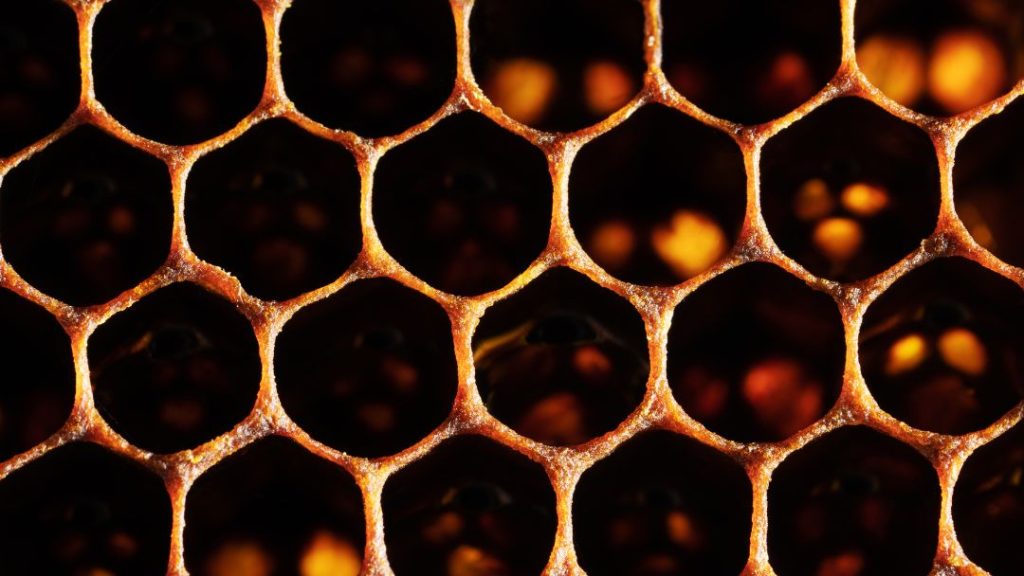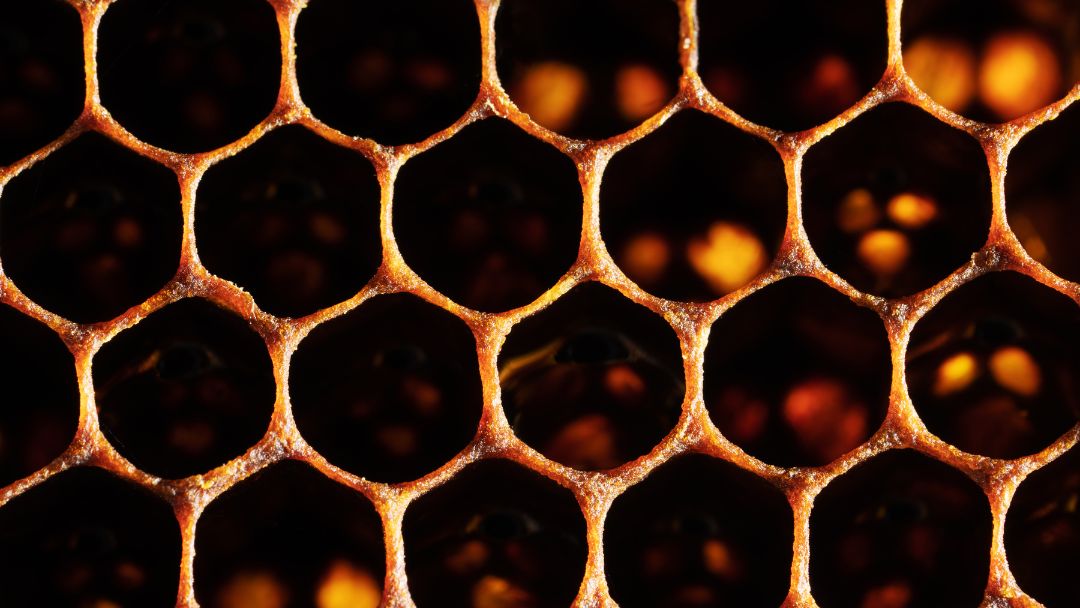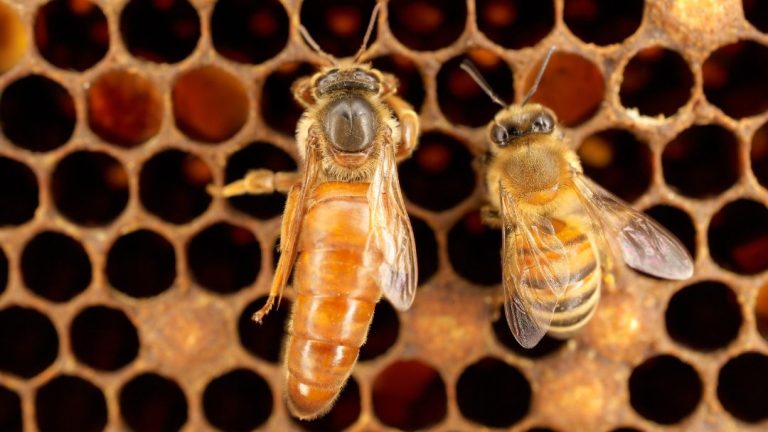What Does Dark Honeycomb Mean? Unveiling the Mysterious Allure
Dark honeycomb refers to a color variation of honeycomb characterized by its darker shade or hue. Dark honeycomb is a term commonly used to describe the appearance of honeycomb wax cells that have a rich, deep brown color.
The dark color can occur naturally or can be a result of factors such as the type of nectar the bees collect or the age of the honeycomb. Dark honeycomb is often sought after by beekeepers and honey enthusiasts for its unique visual appeal and potential flavor notes.
The variation in color does not affect the quality or taste of the honey, but it can add an aesthetic touch to honeycomb products.
What Is Dark Honeycomb And Why Is It So Mysterious?
Dark honeycomb. The mere mention of these words evokes mystery and intrigue. But what exactly is dark honeycomb, and why does it hold such allure? In this article, we will explore the fascinating world of dark honeycomb, its unique characteristics, and the reasons why it captivates our imagination.
How Dark Honeycomb Differs From Regular Honeycomb
Dark honeycomb sets itself apart from regular honeycomb in more ways than one. To understand the distinction, let’s delve into the characteristics that define this enigmatic variety.
Color: Dark honeycomb possesses a deep, rich color that ranges from amber to dark brown. This alluring hue adds a touch of sophistication to the honeycomb and sets it apart from the lighter shades typically associated with regular honeycomb. The intensified color sparks curiosity and makes the dark honeycomb stand out.
Taste: Dark honeycomb offers a unique flavor profile that is unlike any other. Its distinctive taste is marked by robust, earthy notes and hints of caramel. The richness of dark honeycomb provides a more complex and indulgent culinary experience compared to regular honeycomb. The depth of flavor is a testament to its quality and the meticulous process through which it is crafted.
Texture: In addition to its captivating color and taste, dark honeycomb boasts a fascinating texture that sets it apart. The comb has a delicately firm structure that maintains its integrity, even under pressure. This structural resilience contributes to the intrigue of dark honeycomb and highlights its superior craftsmanship.
Antioxidant Properties: Research suggests that dark honeycomb may possess higher levels of antioxidants compared to its lighter counterparts. These natural compounds have been linked to various health benefits, including improved immune function and the prevention of certain diseases. The potential health advantages associated with dark honeycomb add to its allure and make it a sought-after choice among health-conscious individuals.
Why Dark Honeycomb Is So Mysterious
Dark honeycomb is shrouded in mystery for several reasons. Its uncommon color, distinct taste, fascinating texture, and potential health benefits all contribute to the allure and mystique surrounding it. Moreover, the artisanal production process ensures that dark honeycomb remains a rare and exclusive find, further enhancing its enigmatic reputation.
Whether you are an avid honey lover or simply intrigued by the wonders of nature, dark honeycomb offers a captivating journey for the senses. Its allure lies in its unconventional appearance, exceptional taste, and the mystery that surrounds its creation. Explore the world of dark honeycomb and unlock the secrets hidden within its depths.

The Natural Origins Of Dark Honeycomb
When it comes to honey, we often visualize a golden-hued, sweet substance that brings joy to our taste buds.
However, it’s not uncommon to come across dark honeycomb, a variation that sparks curiosity among beekeepers and honey enthusiasts alike.
Factors That Contribute To The Dark Color
A dark honeycomb is a result of various natural factors that influence the color of the honey inside. Let’s explore some of the key contributors:
- Bee Species: Different species of bees produce honey with distinct colors. For example, bees of the Apis mellifera species are known to produce honey with a dark amber shade, while other species may produce honey with even darker tones.
- Flower Sources: The flowers that bees forage from play a crucial role in the color of the honeycomb. Bees have a diverse range of plants to choose from, and each plant produces nectar with its own unique color properties. Plants like lavender, buckwheat, and heather are known to produce dark nectar, resulting in darker honeycomb.
- Season and Climate: The time of year and climate conditions can significantly impact the color of honey. Bees produce lighter honeycombs during spring and summer when they have access to a wider variety of flowers. In contrast, honey made during fall or in regions with predominantly darker flowers can result in a darker honeycomb.
- Processing and Storage: Honeycomb can undergo various processing and storage conditions, which may affect its color. Factors such as exposure to heat, filtration, and the length of time in storage can contribute to the darkening of the honeycomb.
The Relationship Between Bees, Plants, And Honeycomb
Understanding the relationship between bees, plants, and honeycomb is essential to comprehend why dark honeycomb exists. Bees, as diligent pollinators, collect nectar from flowers and store it in their honey stomachs.
During this process, the bees mix enzymes with the nectar, transforming it into honey. Through regurgitation and evaporation, the water content decreases, resulting in a thick, concentrated honeycomb.
This remarkable transformation of nectar into honeycomb is made possible by the interaction between bees and the plants they visit. Bees extract pollen from flowers while collecting nectar, unintentionally pollinating the plants in the process.
This mutualistic relationship ensures the reproduction of the plants and the survival of the bee colonies.
The color of the honeycomb ultimately depends on the collective efforts of bees and the specific floral sources they visit. As the bees visit different plant species, they bring back nectar with varying colors.
Once stored and processed within the hive, the resulting honeycomb reflects the unique combination of flowers the bees have foraged from.
In conclusion, the natural origins of dark honeycomb are multifaceted, involving factors such as bee species, flower sources, season and climate, as well as processing and storage methods.
The intricate relationship between bees and plants reveals how the color of the honeycomb is a testament to the diversity and interconnectedness of the natural world.
Unveiling The Secrets Of Dark Honeycomb Production
Welcome to a fascinating journey into the world of dark honeycomb production. Honeycomb, the sweet and iconic structure created by bees, comes in a variety of colors. While the golden hues are the most commonly seen, dark honeycombs have been garnering attention for their unique appearance. In this article, we will explore the process of dark honeycomb creation and the environmental factors that influence its production. So, let’s dive in and uncover the secrets behind this intriguing phenomenon!
The Process Of Dark Honeycomb Creation
Dark honeycomb is a result of the meticulous work carried out by bees within their hives. Here’s a glimpse into the fascinating process:
- Wax production: Bees start by creating wax, which serves as the building blocks for the honeycomb. Wax glands located on the undersides of their abdomen produce this remarkable substance.
- Assembly: The bees meticulously shape the wax into hexagonal cells, forming the intricate honeycomb structure. Each cell is carefully made in a way that maximizes the amount of honey that can be stored while minimizing the use of resources.
- Honey production: As nectar is brought into the hive by foraging bees, it is transformed into honey through a process of enzymatic conversion and concentration within the honeycomb.
- Ripening: The bees cap the cells with additional wax, allowing the honey to ripen and develop its signature flavor.
- Darkening phenomenon: During the honey ripening process, the enzymes present in the honey react with certain compounds present in the wax. This reaction can lead to the darkening of the honeycomb, resulting in the unique dark honeycomb we see.
Environmental Factors That Influence The Production
The production of dark honeycomb is not solely dependent on the bees’ actions. Environmental factors play an essential role in shaping the final outcome. Let’s explore these factors:
| Environmental Factor | Influence on Dark Honeycomb Production |
|---|---|
| Floral sources: | Bees collect nectar from a variety of flowers. The composition of the collected nectar, including its color and chemical makeup, can influence the resulting honeycomb’s darkness. |
| Climate: | Temperature, humidity, and regional climate patterns can impact the ripening process. Warmer climates may lead to faster enzymatic reactions and darker honeycombs. |
| Seasonal variations: | Flowering seasons affect the availability of different nectar sources. Changes in floral availability can contribute to variations in honeycomb color. |
| Hive conditions: | The conditions within the hive, such as ventilation and hive health, can influence the honeycomb production process. Optimal hive conditions promote consistent and desirable honeycomb coloration. |
As we unravel the secrets behind dark honeycomb production, we gain a deeper understanding of the intricate processes involved. The combination of bees’ remarkable abilities, the chemistry of nectar and wax, and the influence of the surrounding environment produce the dark honeycombs that captivate our senses. So, the next time you come across a dark honeycomb, you can appreciate the hidden wonders within it.
The Nutritional And Health Benefits Of Dark Honeycomb
When it comes to honey, most people picture a golden, runny liquid. However, there’s a lesser-known variant called dark honeycomb that offers a unique taste and texture. But what exactly does dark honeycomb mean?
Dark honeycomb refers to honey that is harvested and consumed in its comb form, meaning the honey is still contained within the wax cells created by bees. Dark honeycomb has gained popularity not only for its distinctive flavor but also for its numerous nutritional and health benefits.
Dark Honeycomb As A Source Of Antioxidants
One of the main reasons why dark honeycomb is revered for its health benefits is its significant antioxidant content. Antioxidants are substances that protect our cells from the damaging effects of free radicals, which can lead to various chronic diseases.
Dark honeycomb contains a wide range of antioxidants, including flavonoids, phenolic acids, and enzymes like glucose oxidase, catalase, and peroxidase.
| Antioxidant | Function |
|---|---|
| Flavonoids | Protect against cell damage |
| Phenolic acids | Reduce inflammation |
| Glucose oxidase | Assist in glucose conversion |
| Catalase | Break down hydrogen peroxide |
| Peroxidase | Protect against oxidative stress |
Dark Honeycomb’s Potential Medicinal Properties
Aside from its antioxidant properties, dark honeycomb also exhibits potential medicinal properties that can benefit our health. Dark honeycomb is known for its antibacterial and antifungal properties, making it a natural remedy for various infections.
It can help soothe sore throats, accelerate wound healing, and alleviate symptoms of common respiratory conditions, such as coughs and colds.
Moreover, dark honeycomb has been linked to improving digestive health. It acts as a prebiotic, promoting the growth of beneficial gut bacteria and aiding in digestion. The natural enzymes present in dark honeycomb can also enhance nutrient absorption and relieve digestive discomfort.
Overall, dark honeycomb is not just a tasty treat, but it also offers an array of nutritional and health benefits. Its high antioxidant content and potential medicinal properties make it a valuable addition to any diet. Whether you prefer enjoying it as it is or incorporating it into your favorite recipes, dark honeycomb is a delicious and wholesome choice.
Exploring the Culinary Uses Of Dark Honeycomb
Dark honeycomb is a delectable ingredient that adds a unique flavor and texture to a variety of dishes.
Whether you’re a seasoned chef or an amateur cook, incorporating dark honeycomb into your culinary creations can take your meals to the next level.
Dark Honeycomb In Gourmet Cooking
Gourmet cooking is all about elevating the dining experience, and dark honeycomb plays a significant role in achieving that. Its deep caramelized flavor and delicate crunch make it a versatile ingredient that can be used in both sweet and savory dishes.
When it comes to dessert, dark honeycomb can be used to enhance the richness of chocolates, ice creams, and custards. The combination of bittersweet chocolate and the sweetness of honeycomb creates a flavor profile that is simply irresistible. You can also sprinkle crushed honeycomb on top of cakes or fruit salads to add a delightful crunchy element.
In savory dishes, dark honeycomb can bring an unexpected dimension to your culinary creations. Its natural sweetness pairs well with various cheeses, especially those with strong and tangy flavors. A combination of blue cheese and dark honeycomb can create a heavenly balance of tastes in a salad or on a cheese platter.
Pairing Dark Honeycomb With Different Foods
The key to successfully using dark honeycomb in your cooking lies in finding the right food pairings. By pairing it correctly, you can enhance the flavors of both the honeycomb and the accompanying ingredients, creating a harmonious blend of tastes.
Here are some exciting food pairings to consider:
- Pair dark honeycomb with blue cheese for a savory and sweet cheeseboard.
- Combine dark honeycomb with ripe apples for a simple yet delicious dessert.
- Add crushed honeycomb to your chocolate mousse for an indulgent treat.
- Try dark honeycomb with roasted pork for a unique balance of flavors.
| Food | Best Dark Honeycomb Pairing |
|---|---|
| Cheese | Blue cheese, goat cheese, or brie |
| Fruits | Apples, pears, or figs |
| Chocolate | Dark chocolate or milk chocolate |
| Ice Cream | Vanilla, caramel, or coffee-flavored ice cream |
| Meats | Pork, lamb, or duck |
Remember, experimenting with different pairings is part of the joy of cooking! Don’t be afraid to get creative and explore new combinations. Dark honeycomb’s rich taste and crispy texture are sure to leave a lasting impression on your taste buds.
Conclusion
To sum up, understanding the meaning of dark honeycomb is crucial for honey enthusiasts and beekeepers alike. Its deep, rich color indicates the presence of minerals and antioxidants, making it a highly sought-after variety. As a natural sweetener, dark honeycomb offers both health benefits and a delightful flavor.
Incorporating it into your diet can enhance both your nutrition and culinary experiences. So, explore the world of dark honeycomb and indulge in its unique and enticing qualities. Happy honey hunting!


